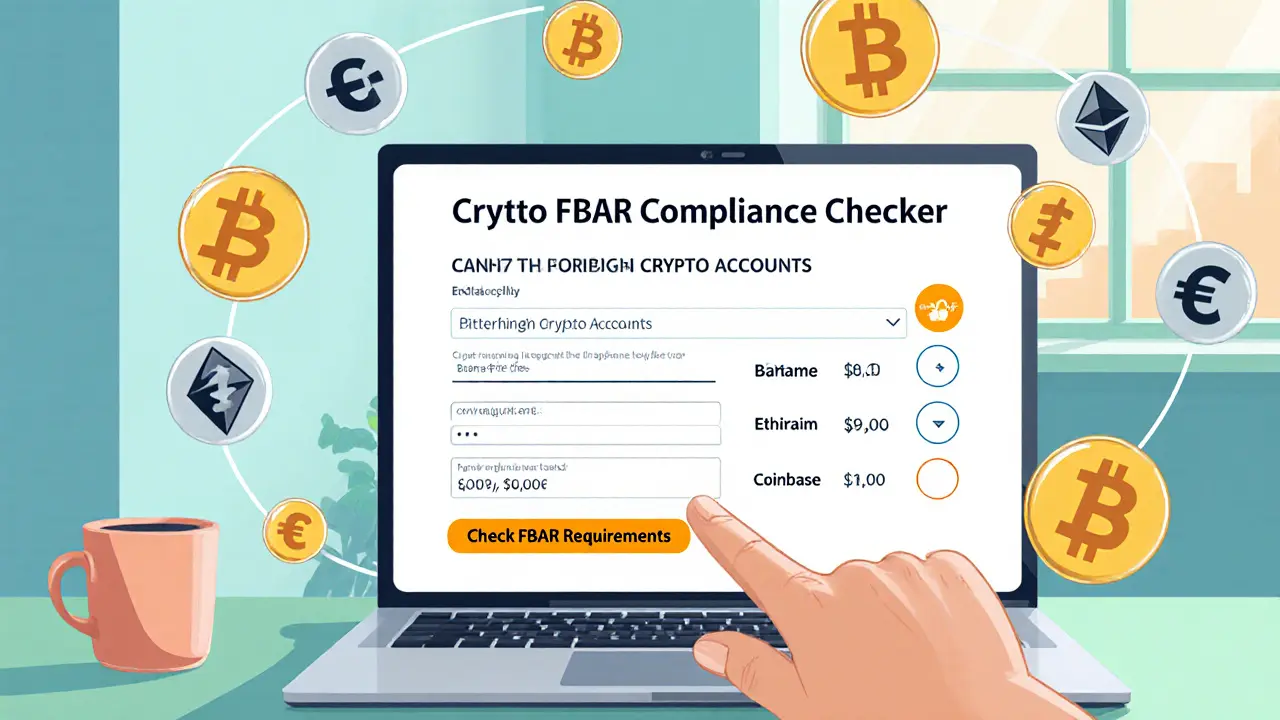Crypto FBAR Compliance Checker
Instructions
Enter information about your cryptocurrency accounts below to check if they meet FBAR filing requirements.
When a U.S. person holds crypto on a foreign exchange that tops $10,000, the question quickly becomes: FBAR or not? The answer hinges on how the IRS and FinCEN view digital wallets, hybrid balances, and the timing of the valuation. Below you’ll find a step‑by‑step guide that cuts through the jargon, shows where the rules actually sit, and gives you a practical checklist so you can stay compliant without over‑filing.
What is the FBAR?
FBAR (Foreign Bank and Financial Account Report) is a filing requirement under the Bank Secrecy Act. Any U.S. person who has a financial interest in, or signature authority over, a foreign financial account that exceeds $10,000 at any point during the calendar year must submit FinCEN Form 114 by October15 of the following year.
Key thresholds and filing deadline
The $10,000 limit is an aggregate figure. It doesn’t matter if you have one $9,900 account and another $200 account; together they push you over the line and trigger a filing. The deadline is strict-miss it and you face steep penalties, ranging from $10,000 per missed filing to up to 50% of the account’s balance for willful violations.
Where do cryptocurrency accounts fit?
The current regulatory landscape is shaped by FinCEN Notice 2020‑2, released on December31,2020. That notice states that a foreign account that holds only virtual currency is **not** reportable on the FBAR “unless it is a reportable account because it holds other assets.” In plain English, a pure crypto wallet on a non‑U.S. exchange is exempt-for now.
Pure crypto versus hybrid accounts
Understanding the distinction is critical because the moment an account also holds fiat (EUR, GBP, USD, etc.), it becomes a standard FBAR‑reportable account. Below is a quick comparison.
| Feature | Pure Crypto Account | Hybrid Account |
|---|---|---|
| Reportable under FBAR? | No (per Notice2020‑2) | Yes (standard FBAR rules) |
| Typical Exchanges | Binance.com, KuCoin, Bitfinex | CoinbaseInternational, Kraken (if fiat balances exist) |
| Key Documentation | Daily USD‑equivalent balance sheets | Account statements showing fiat holdings |
| Compliance Risk | Low (current exemption) | High (must file if >$10K) |
How to determine if you need to file
- List every foreign exchange, wallet, or custodial service where you hold crypto.
- For each account, identify whether fiat is also stored. If yes, flag it as a hybrid account.
- Convert the daily balance of each account to U.S. dollars using the market price on that day.
- Find the maximum aggregate value across all accounts for the year. If the sum ever exceeds $10,000, you must file.
- Gather the required details for each reportable account:
- Financial institution name and address
- Account number or other unique identifier
- Maximum value in USD

Understanding “signature authority” and “financial interest” for crypto
Signature Authority means you can direct the foreign institution to move money-think of having the private key or being an authorized user on a custodial platform. Financial Interest captures ownership, including indirect stakes via entities where you hold more than 50% of voting power. Even if you don’t control the private key directly, a partnership that owns the wallet can trigger FBAR obligations.
What form do you actually file?
The filing vehicle is Form 114, submitted electronically through the BSA E‑Filing system. The system asks for the same details listed in step5 above, plus a brief description of the account type (e.g., “foreign cryptocurrency exchange - hybrid account”).
Step‑by‑step filing checklist
- Register for a BSA E‑Filing account (or have your tax preparer do it).
- Collect all account statements for the calendar year.
- Use a crypto tax calculator or spreadsheet to pull daily USD values.
- Many tools (CoinLedger, Koinly) can export the needed CSV.
- Identify the highest aggregate balance and confirm it exceeds $10,000.
- Complete Form 114, entering each hybrid account’s details.
- Leave pure‑crypto accounts out unless you adopt a conservative approach.
- Submit the form by October15. Keep the confirmation number for your records.
- Retain all supporting documentation for at least five years.
Conservative vs. strict compliance approaches
Two schools of thought dominate the conversation:
- Conservative reporting: Treat every foreign crypto account as reportable once the combined balance tops $10K. This strategy hedges against future rule changes and aligns with the advice from firms like CoinLedger.
- Strict adherence: Follow the letter of Notice2020‑2, filing only for hybrid accounts. This minimizes paperwork and avoids unnecessary penalties, as recommended by Bitwave and many tax attorneys.
Both approaches have merit. If you expect regulatory amendments that will retroactively cover crypto, the conservative path may save you a late‑year scramble. If you prefer to keep your filings lean, stick to the current exemption-just keep immaculate records.
Record‑keeping best practices
- Maintain a master spreadsheet with columns: Date, Exchange, Crypto Balance, USD Value, Fiat Balance (if any).
- Save PDF statements from each exchange; many platforms now provide weekly summaries.
- Back up the data in a secure, encrypted cloud folder-preferably one that’s separate from your crypto wallets.
- Document any changes in account ownership or control, especially if you move assets into an LLC or trust.
What’s on the horizon?
FinCEN has signaled that a rulemaking effort will likely bring virtual currency into the FBAR definition within the next 1-2years. That means today’s pure‑crypto accounts could become reportable retroactively, or at least be subject to a transitional filing period. Keeping the records described above positions you to comply quickly when the new rules land.

Frequently Asked Questions
Do I need to file an FBAR for a Binance account if I never held fiat there?
Under the current FinCEN Notice 2020‑2, a Binance account that holds only cryptocurrency is exempt from FBAR filing, even if the total value exceeds $10,000. However, many advisors suggest filing anyway if you want to be on the safe side.
What if I have several small foreign wallets that together exceed $10,000?
The FBAR threshold is aggregate. Add up the maximum USD value of each wallet for the year; if the sum crosses $10,000, you must file for each account that contributed to the total.
How do I value volatile crypto holdings for FBAR purposes?
Use the market price on the day the balance peaked. Most crypto tax software can generate a “maximum daily balance” report, which satisfies the FBAR requirement.
Can a crypto‑focused LLC trigger FBAR filing for its owners?
Yes. If the LLC holds a foreign crypto account and U.S. owners have a >50% ownership interest, they have a financial interest and must include the account on their personal FBAR.
What penalties apply for failing to file an FBAR?
Non‑willful violations can cost up to $10,000 per missed filing. Willful failures can attract penalties up to 50% of the account balance per year, plus criminal prosecution in extreme cases.


The moment you stare at those FBAR thresholds, you feel the weight of every digital coin you own, like a silent storm gathering over the horizon. The law draws a line at $10,000, and suddenly the abstract world of crypto becomes a courtroom drama. We all chase freedom, yet freedom comes with paperwork, and that irony is almost poetic. The pure‑crypto versus hybrid split feels like a philosophical fork in the road, demanding us to choose between simplicity and caution. In the end, compliance is the bridge between our dreams and the reality of the tax code.
Oh sure, FinCEN has a secret agenda to track every altcoin as if they’re government spies. In reality, the exemption for pure crypto is a thin veil that could be ripped away tomorrow.
lol the fbar thing is just another tax thing i dont even care.
Hey folks, just a quick heads‑up: if you’ve got any fiat showing up on a foreign exchange, you really do need to file that FBAR. Keep a simple spreadsheet, note the max USD value, and you’ll be set. It’s not rocket science, just good habits.
First, congratulations on taking the first step toward understanding FBAR compliance for crypto – that in itself is a big win. The process begins with gathering every account statement from each foreign exchange you use, because the IRS wants a complete picture. Next, you’ll need to convert the daily balances of those accounts into U.S. dollars; most tax software can generate a “maximum daily balance” report that satisfies this requirement. Once you have those numbers, add them together for each day of the year – the aggregate is what matters, not just the individual account values. If on any day the total exceeds $10,000, the filing clock starts ticking and you must submit FinCEN Form 114 by October 15 of the following year. Remember, the distinction between pure‑crypto and hybrid accounts is crucial: a hybrid account holding even a small amount of fiat instantly becomes reportable, regardless of the crypto value. For pure‑crypto wallets, the current exemption applies, but it’s a good idea to keep meticulous records because the rules may change, and retroactive filing could become a requirement. Speaking of records, store every PDF statement, CSV export, and screenshot in an encrypted cloud folder – think of it as your compliance vault. When you’re ready to file, register for a BSA E‑Filing account or have your tax professional do it; you’ll need the institution name, address, account number, and the maximum USD value. After submitting the form, keep the confirmation number safe – it’s your proof of compliance. Finally, retain all supporting documentation for at least five years, as the IRS can audit retroactively. By following these steps, you’ll avoid costly penalties and sleep better at night, knowing you’ve met your FBAR obligations.
Let’s think of FBAR compliance as a landscape rather than a checklist. The aggregate $10,000 threshold means we must consider the sum of all foreign holdings, not just the biggest wallet. Hybrid accounts blur the line between crypto and traditional finance, pulling them into the reporting net. Pure‑crypto accounts remain exempt for now, but they’re on the radar for future rulemaking. The best approach is to treat the current guidance as a living document and stay adaptable.
Good point, just keep a simple table and you’re fine.
Exactly, a spreadsheet with columns for date, exchange, crypto balance, USD value, and fiat balance will save you endless headaches later when the IRS asks for details.
Honestly, I think most people overthink this – just file if you’re over the limit, otherwise chill.
Don’t forget that staying organized now prevents panic later! It’s easy to overlook a tiny fiat balance hidden in a crypto exchange, but that could push you over the FBAR line.
From a compliance perspective, leverage crypto‑tax tools that export daily USD valuations; this data feeds directly into your FBAR aggregate calculations and reduces manual errors.
Look, the government loves to make a mountain out of a molehill when it comes to crypto. Filing a FBAR for hybrid accounts is just another way to stick their fingers in our wallets. If you’re patriotic, you’ll fight the overreach and keep your crypto free.